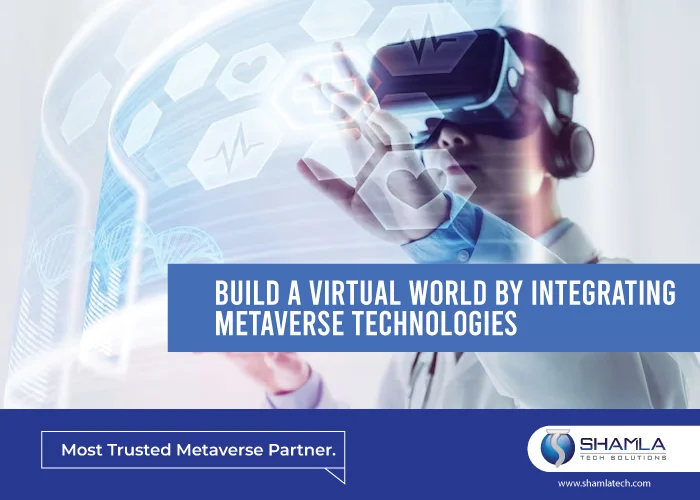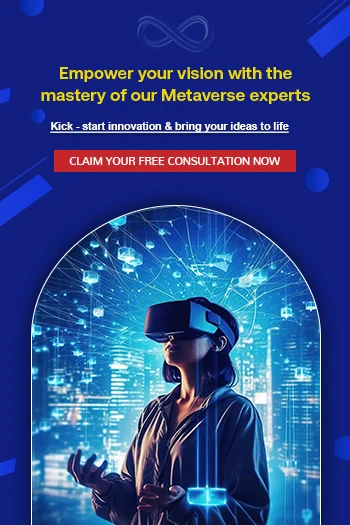The concept of the Metaverse, a fully-realized virtual world has been gaining popularity in recent years. With the growth of virtual and augmented reality technology and the increasing prevalence of online communication and entertainment, many see the Metaverse as a natural next step in the evolution of the internet. Several major companies and platforms have already started investing in the development of Metaverse technologies. There is also great interest among investors and entrepreneurs in the potential economic opportunities of the Metaverse. Some see it as a potential new frontier for e-commerce, advertising, and entertainment, and predict that it could become a major driver of economic growth in the coming years.
VARIOUS KEY TECHNOLOGIES USED IN THE METAVERSE DEVELOPMENT
The Metaverse is a virtual world that allows people to interact with each other and with digital objects in a shared space. Metaverse is becoming an increasingly important space for businesses to explore. The Metaverse presents significant opportunities for businesses to grow and innovate. As technology continues to evolve, it is important for companies to stay up to date with the latest developments and explore how they can leverage the Metaverse to achieve their goals. The development of the virtual world requires a range of Metaverse technologies, including:
- Virtual Reality (VR)
- Augmented Reality (AR)
- Blockchain technology
- 3D Modeling and Animation
- Artificial Intelligence (AI)
- Cloud Computing
- Internet of Things (IoT)
- Edge Computing
- Web 3.0
- Mixed Reality (MR)
1.VIRTUAL REALITY (VR)
Virtual Reality (VR) has become an increasingly important technology in the Metaverse development. VR helps to create fully immersive experiences in the Metaverse. It allows users to feel as if they are really in a different world. This can include everything from realistic environments to virtual avatars that respond to a user’s movements. VR technology enables the creation of social experiences within the Metaverse, such as virtual meetings, concerts, and other events. Users can interact with each other in real time as if they were in the same physical space. VR technology facilitates companies to create virtual storefronts, product demonstrations, and other interactive experiences. It allows users to engage with the products in a new way.
2.AUGMENTED REALITY (AR)
Augmented Reality (AR) can play a significant role in the development of the Metaverse. When AR technology combines with the Metaverse, it can create a unique and interactive experience for users. One of the primary uses of AR in Metaverse development is to enhance the virtual experience by integrating digital elements into the real world. This can be possible by using wearable devices such as AR glasses or smartphones to overlay digital information onto the real world, making it seem like the virtual world is merging with the physical world. For example, a user could walk down the street while using AR glasses, and see virtual shops and other digital elements that are integrated with the real-world environment. This could create a more immersive and engaging social experience, as users can interact with each other in real time, regardless of their physical location.
3.BLOCKCHAIN TECHNOLOGY
Blockchain technology is one of the key Metaverse technologies in the development of the virtual world. Blockchain technology helps to create a decentralized system of ownership, where users can have full control over their digital assets. This can help prevent theft and fraud and give users more freedom and flexibility over their virtual possessions. Blockchain can enable interoperability between different Metaverse platforms, allowing users to transfer their assets and identities between different virtual worlds. This can create a more open and connected Metaverse where users can move seamlessly between different virtual environments. Blockchain allows the creation of smart contracts, which are self-executing contracts that can automatically enforce the terms of an agreement between parties.
4.3D MODELING AND ANIMATION
Metaverse developers use 3D modeling to create virtual environments that look and feel real. These virtual environments may include everything from landscapes, buildings, and vehicles to furniture and other objects. By using 3D modeling software, developers can create virtual objects and environments with intricate detail and realistic textures. In addition to creating virtual environments, 3D modeling and animation are used to create characters that populate the Metaverse. Developers can use these tools to create lifelike avatars with realistic movements and expressions. This is particularly important for games, social experiences, and other applications that rely on user interaction. 3D modeling and animation can be used to create interactive objects that respond to user input. 3D modeling and animation can be used to create engaging and immersive user experiences.
5.ARTIFICIAL INTELLIGENCE (AI)
The development of the Metaverse involves the use of various technologies, including Artificial Intelligence (AI). AI helps to create personalized experiences for users in the Metaverse. By analyzing user data, AI algorithms can customize the environment and interactions to suit the preferences of each user. It also helps to predict user behavior and preferences based on past interactions, allowing for more customized and tailored experiences. This can improve user engagement and satisfaction. Users can interact with AI-powered chatbots or virtual assistants, which can provide them with information, answer questions, or assist them in various tasks. This can enable users to navigate and interact with the Metaverse more easily and efficiently. AI can be used to generate content such as virtual landscapes, buildings, and objects. This can significantly reduce the time and effort required for content creation, making it easier and faster to develop the Metaverse.
6.CLOUD COMPUTING
The Metaverse requires vast amounts of data storage to support the creation and management of 3D models, textures, animations, and other digital assets. Cloud storage provides a highly scalable and cost-effective solution for storing and accessing these assets. Cloud computing provides the necessary infrastructure to support the massive amount of data and processing power required to run the Metaverse. It helps to maintain a smooth and responsive user experience in a Metaverse with a large and dynamic user base. Cloud computing also provides the networking infrastructure necessary to connect users in the Metaverse and enable real-time communication and collaboration. Cloud-based networking solutions such as load balancers, content delivery networks, and edge computing services can ensure that users have low latency and high reliability when interacting with the Metaverse.
7.INTERNET OF THINGS (IOT)
The Internet of Things (IoT) is an important technology for Metaverse development by providing a network of connected devices that can collect and transmit data in real time. IoT-enabled smart homes and buildings can provide a realistic and immersive environment in the Metaverse. IoT devices can be used to collect real-time data about the virtual environment and user behavior within the Metaverse. This data can be used to optimize the virtual environment and personalize the user experience. IoT can help to create a more seamless and immersive experience in the Metaverse, by integrating real-world data and providing a more personalized and responsive environment for users.
8.EDGE COMPUTING
Edge computing is a distributed computing model that involves processing data near the edge of the network, rather than sending it to a centralized data center. The goal of edge computing is to reduce latency and increase the speed of data processing. In the context of Metaverse development, edge computing helps to improve the performance of virtual environments. Metaverse environments require large amounts of computational power to create and render complex virtual spaces. By leveraging edge computing, developers can distribute the processing of these environments across multiple devices. More over networks, reducing the burden on any single server or data center.
For example, in a Metaverse game where players are exploring a virtual city, edge computing helps to distribute the processing of different parts of the city to different edge devices, such as mobile phones or gaming consoles. This allows players to move seamlessly from one area of the city to another, without experiencing any lag in rendering.
9.WEB 3.0
The integration of Web 3.0 technology in Metaverse development is becoming increasingly important as it offers various advantages. Web 3.0 technology is all about decentralization. By integrating this technology, Metaverse developers can create a decentralized network that is not controlled by any single entity. This can help to ensure greater transparency, security, and privacy in the Metaverse. With the use of Web 3.0 technology, it is possible to create interoperable applications that can seamlessly work together across different platforms. This will enable Metaverse users to interact with different Metaverse platforms and applications using a single digital identity. Web 3.0 technology can also be used to tokenize virtual assets in the Metaverse. This will enable users to own, trade, and transfer virtual assets in a decentralized and secure manner.
10.MIXED REALITY (MR)
Mixed Reality (MR) has great potential for use in Metaverse development. MR involves the integration of virtual and real-world elements, allowing users to experience digital content in a more immersive and interactive way. MR technology can enable users to create avatars that reflect their physical appearance and movements. This can increase the sense of presence and immersion in the Metaverse. MR can allow users to manipulate virtual objects in the Metaverse using hand gestures, similar to how we interact with real-world objects. This can make the Metaverse feel more like a natural extension of the real world. MR can enable the creation of interactive experiences in the Metaverse that blend physical and virtual elements. For example, users can interact with virtual objects that are overlaid on top of the physical environment.
These are just a few of the technologies of Metaverse that are being used and developed to create the virtual world. As the concept of the Metaverse continues to evolve, it is likely that new technologies and innovations will emerge to support its development.
HOW SHAMLA TECH HELPS YOU WITH METAVERSE DEVELOPMENT?
Shamla Tech is a leading Metaverse Development company that specializes in creating virtual worlds, which can be easily accesses by multiple users simultaneously. We use various technologies to create Metaverse, such as extended reality, 3D modeling, blockchain, artificial intelligence, and more. We can offer various advanced Metaverse app development solutions that help to grow your business. By leveraging these technologies, they can create a virtual world that is engaging, interactive, and fun for users to explore. We can create 3D models, textures, animations, and other assets needed for your virtual world.
Our experts can also help you develop the software infrastructure that powers your virtual world, including the server-side software and client-side applications. As a renowned Metaverse Development Company, we help you optimize your virtual world to run smoothly on a wide range of devices and platforms. We can also help you scale your virtual world to handle a growing number of users, and provide support to your users in case they encounter any issues. Shamla Tech can help you bring your vision to life, and provide the technical expertise needed to make your virtual world a success.


